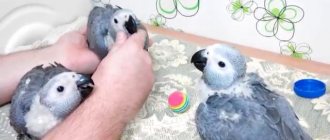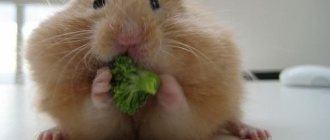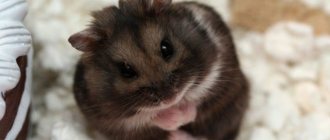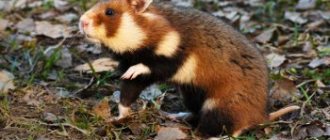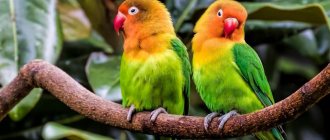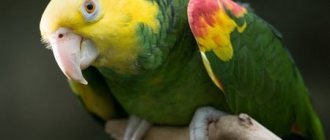What types of hamsters are there? How to distinguish them from each other? What types of hamsters are suitable for keeping at home? You will find answers to these questions in the article.
Let’s make a reservation right away that we will only talk about varieties of hamsters that can be tamed and domesticated. Let's take a quick look at wild rodents.
If you don’t understand breeds, this will grow up.
Dzungarian (aka Sungur)
Baby jungarik.
Yes, this is not a typo - the Dzungarian hamster and the Sungur hamster are the same breed. In common people, the pet is called a dzhungarik after the name of the region in China, its natural habitat. Sungurik - from the scientific name Phodopus sungorus.
Other erroneous names for dwarf hamsters are Siberian hamster and Russian dwarf. Such breeds of pets do not exist in the classification; if they are trying to sell you a Siberian or Russian at an inflated price, find another seller.
Sungursky is a dwarf species, grows up to 10 cm in length and gains a weight of 45-65 grams. The “feet” on the paws are covered with hair. The color on the back is dark, on the belly it is almost white. A characteristic difference is a clearly defined thin dark stripe along the ridge.
The “standard” back color is brown or dark gray. But there are decorative colors:
- Sapphire (gray with a bluish tint);
- Pearl (snow-white);
- Tangerine (similar in color to the golden Syrian).
The Dzhungarik changes its coat color depending on the time of year (lighter in winter), but this rarely happens at home.
The character is perhaps the friendliest among all hamsters. Djungarians often like to be stroked on their backs and bellies; they willingly fall asleep in your arms.
Lives in captivity for an average of 3 years, but with proper care, 4 are possible.
You can house opposite-sex pairs (just keep in mind that they will reproduce quickly and actively). It is better not to keep same-sex Dzungarians together; they do not get along well.
The tiny size leaves an imprint on the maintenance and feeding of the baby. Read about care in detail in this material.
Taylor
Taylor is the most decorative of all types of domestic rodents. This miniature pet grows to a maximum of 8 centimeters. However, the main feature of this breed is that the female and male care for their offspring together, which is quite a rare occurrence for hamsters. For livestock breeders planning to keep a couple of pets, this is one of the best options.
Another characteristic feature of this species is that they often bite. The animal can bite the “feeding” hand at the most inopportune moment, so it is not advisable to give representatives of the breed to children of preschool age. When caring for a pet, it is advisable to use a special glove.
Syrian
The golden king of children's hearts.
The second most popular species is the Syrian hamster. This species is medium-sized and much larger: the body length is considered to be 12 cm, but there are individuals up to 20 cm tall (this is the largest hamster among pets). The usual color is golden (reddish, peach). Often, for marketing purposes, sellers call this breed Royal, and the name Yellow Hamster is found. Many consider it the most beautiful breed.
There are simply countless decorative colors obtained as a result of selection. The Syrian can be of almost any color, as well as multi-colored.
The character is a little more absurd than that of the Djungarians, but you can tame the Syrian. Females are angrier than males, so we recommend boys for solitary housing. If you are planning to get several Syrian animals, house them separately, even in pairs (only house them for the duration of mating).
They live 3-4 years; long-livers have been known to live up to 5 years.
We have outlined everything you need to know about the maintenance and nutrition of the Syrian breed in this article.
Angora hamster
There is no breed of Angora hamster. This is often the name given to Syrians who are extremely shaggy and have long hair (up to 10 cm). Decorative breed, famous for its fluffiness. The coat requires additional care - keep this in mind if you are planning to get a shaggy hamster.
Golden hamster
Naturally colored Syrians are most often called golden, but there are also representatives of other breeds of this color (for example, tangerine dzhungarik).
Care
Frequent illnesses
The most common problem with Djungarian hamsters is injuries that the animal can receive when falling. When injured, you may notice that the hamster's paw is twisted or turned at an unnatural angle. From pain, the animal can fall into a state of shock: it is motionless and does not react to what is happening. An injury is a reason to take your hamster to the vet as soon as possible. Treatment depends on the condition of the animal and the severity of the injury.
Susceptible to respiratory viral infections. Infection is indicated by:
- decreased activity;
- sneeze;
- loss of appetite.
There is no special treatment for viral diseases in Djungarian hamsters. It is recommended to provide your pet with vitamin supplements and high-quality food to strengthen his body’s immune defense and speed up recovery.
Conjunctivitis
If your hamster cannot open his eyes and there is a small amount of pus on his eyelids, he may have developed conjunctivitis. It is recommended to treat conjunctivitis by washing the animal’s eyes with a weak saline solution. In order not to make a mistake in the concentration, you can buy saline solution with a sodium chloride concentration of 0.9% at the pharmacy.
Cataract
Cloudiness of the pupil indicates cataracts. This disease usually develops in older individuals. It is impossible to cure cataracts.
Long teeth
Refusal to eat may indicate a dental injury or that too long teeth are preventing you from eating. In such cases, the teeth should be straightened by contacting a veterinarian. To prevent excessive growth of incisors, you should constantly keep a chalk stone in the cage.
Dermatophytosis
Peeling skin and hair loss are a sign of eczema or dermatophytosis. Problems with the skin indicate either stress or the presence of an allergen in the cell. Treatment of eczema and dermatophytosis is carried out by a veterinarian.
Parasites
If your hamster is constantly itching, restless, and has red dots visible on its skin, it most likely has parasites (lice or fleas). On sale you can find many products designed to combat skin parasites in rodents. A veterinarian will help you choose the safest one for your animal.
Refusal to eat, diarrhea, and loud bowel movements are symptoms of an intestinal infection. They can be cured with antibiotics.
How to properly care?
It is enough to provide him with everything he needs (a spacious cage, food, a drinking bowl with fresh water). There are some subtleties that will create optimal conditions for the animal. To help your pet get used to its owner faster, it is recommended:
- talk to the animal in a quiet, calm voice;
- pick up the hamster delicately and gently, supporting it under the front paws;
- before touching the animal, give it the opportunity to sniff your hand: this way the animal will quickly get used to the owner’s smell.
It is important to clean the cage regularly. This should be done once every 7-10 days. The hamster is placed in a small carrier cage or cardboard box with holes for ventilation. The old filler is removed and replaced with a new one, leaving a small amount (to make the animal feel more comfortable). Once every 4 weeks it is necessary to wash the cage or aquarium with warm water and laundry soap.
How not to care
To avoid harming your hamster, you should:
- bathe your pet in soap and water. The hamster can handle cleaning its fur on its own. You can buy special sand for him for bathing guinea pigs. Sand is poured into the bathing suit and placed in the cage. After some time, the hamster begins to wallow in the sand and clean its skin;
- buy a “comrade”. Hamsters do not tolerate rivals and defend their territory. They only need a partner for reproduction; the rest of the time, dzhungarikas feel great alone. If the need to house two hamsters in one cage is great, you must first divide the cage into two halves using a partition. The partition can be removed only when the animals get used to each other and do not show signs of aggression;
- leave the hamster on a high surface. Rodents are lowland animals and do not understand what height is and its dangers. Dzungarik may fall and be seriously injured and even die.
In order for your hamster to quickly get used to it and trust its owners, you should not:
- make sudden movements near the animal;
- scream near the cage, play loud music;
- pick up a sleeping or recently awakened animal. This can frighten the hamster so much that it bites the owner, which is quite painful;
- roughly take an animal by the withers to lift it.
Campbell's hamster
The closest relative of the dzhungarika is Campbell.
Another representative of the dwarf breed. It is very similar to the Djungarian, both in size and color, so it is not easy to recognize the breed. The main differences between Campbell and Dzungarian:
- The color has a golden tint, while the Djungarian has a darker coat.
- When viewed from above, the shape resembles a figure eight, while the jungarik has an oval
- The stripe on the back is less distinct
The signs are not exact, so we advise you to read the material on our website, which covers in detail the question of how to determine the breed of hamster (to distinguish a hamster from a Campbell).
Life is shorter than that of the Dzungarian breed, on average 2 years in captivity.
Roborovsky's hamster
Less than small - Roborovsky's baby.
The smallest hamster we recommend for home keeping is the Roborovsky hamster. It grows only 4-5 cm in length. The back is golden or dark brown, the belly is white. Hamsters live in captivity for up to 4 years.
They are very difficult to tame, but this is the only breed that can be housed in groups of the same sex. Those. this species is no longer for those who like to “squeeze” hamsters, but for those who prefer to watch the life of a colony of nimble babies.
Answers to popular questions
Before getting their first hamster, people ask many questions. We have collected the most popular of them and will try to provide brief information.
What breed of hamster is best to buy for a child?
Several factors need to be taken into account: the age of the child, how many hamsters you plan to buy, whether you can look after him and devote a lot of time.
Let's say the only hamsters that can respond to a name are Syrian ones. Djungarians live only one at a time. Campbell's are more social, they need a friend so they don't get bored.
Hamster and baby
Males of any hamsters, as a rule, are larger than females, but more “fragrant” because they mark their territory, i.e. You need to clean the cage more often. Are you and your child ready for this? You should not completely entrust the maintenance of the animal to the child; be sure to control the processes.
What is the largest breed of hamster?
The largest hamster is the Karbysh breed. Its dimensions reach 35 cm and weight up to 700 g. It lives only in the wild and cannot be tamed. Among domestic hamsters, the largest is the Syrian.
What is the smallest breed of hamster?
The smallest breed of hamster is the Roborovsky. And among the wild ones is Taylor's hamster.
Djungarian or Syrian hamster, which is better to get?
This question is quite broad. Take whoever you like best.
What are the differences between these breeds? The Syrian hamster is larger, calmer, and will be able to respond to its name. Such a hamster needs a cage more than a dwarf.
Djungarian hamster eats seeds
The Djungarian hamster is smaller, more mobile and does not need a two-story cage.
The life expectancy of both is almost the same.
Common hamster
The most common wild pest.
It is difficult for sellers to understand what kind of animal the buyer considers “ordinary”, so they can sell anything. Let's clarify this issue: the common hamster (aka wild, aka karbysh) is a significant pest of human crops and is almost never found as a pet.
What does a normal hamster look like? It reaches a length of 35 cm, has a long tail - up to 8 cm. The abdomen is usually black, the back and sides are bright and spotted. Not recommended for keeping or taming.
Reproduction
In their natural habitat, dwarfs breed from April to September. At home, under good conditions, they can give birth throughout the year.
Hamsters are able to reproduce after reaching three months of age. The female's gestation period is three weeks; at the end of pregnancy, the female gives birth to 5 to 8 cubs. When the time comes for the female to give birth, it is better to place the cage in a quiet place with dim lighting. It is advisable that in the room where the cage is located there are no loud sounds, no TV or music playing.
Hamsters are born hairless and blind. They develop fur at the end of the first week of life, and after another week they open their eyes. You should not touch newborn hamsters: a foreign smell can cause the female to reject the offspring and even destroy the cubs.
Newborn hamsters feed on mother's milk for approximately the same amount of time. During lactation, you need to add a little boiled egg white, cheese or boiled chicken to the female's diet.
Young females or animals under stress may abandon their young and even begin to eat them. If the cubs have not yet reached the age of ten days, it is impossible to save them: it will not be possible to feed a newborn hamster.
The young should be housed in separate cages a month after birth. Young hamsters should not be near their mother for more than five weeks. This is due to the fact that after a month the hamster is already able to fertilize a female, including her own mother. And such frequent births can harm the health of the animal.
Albino hamster with red or black eyes
Such a handsome man can be of any breed.
And again we have to disappoint you - there is no separate breed of albinos with a specific eye color. Almost any living creature (even humans) can be born an albino.
Usually hamsters have black eyes, but albinos often have impaired eye pigmentation (this is the color on the inner surface of the eyeball). As a result, it becomes transparent and the red color we see is blood vessels.
An albino with any eye color is no different in caring for an ordinary animal of the same breed.
What does it eat in nature?
The rodent is omnivorous. He has a good appetite. The main diet consists of plant foods, but in spring and summer it will not refuse insect larvae, small reptiles, crustaceans and mollusks.
With the onset of autumn, the animal consumes more plant foods. At this time, the hamster's harvesting season begins. The field hamster's diet is based on corn, peas, grains of wheat, buckwheat, millet, potatoes and carrots, the reserves of which he stores in pantries.
Wild hamster - carbysh
The rodent creates supplies thanks to its cheek pouches, which it uses to carry food. One bag holds up to 50 g of grain, which the animal can carry over a distance of more than a kilometer, supporting the bags with its front paws.
Wild hamsters store large amounts of food in their burrow. Burrows with huge reserves were discovered, hundreds of times exceeding the rodent's own weight.
Karbysh eat food while sitting on its hind legs. He eats by holding the food with his front paws and stuffing the food into one cheek, then the other, then quickly chews it.
Other breeds of hamsters
Let's take a look at the representatives of hamsters that are not recommended to be kept at home. You need to know about them, at least so that they don’t slip you a wild animal under the guise of a domestic, soft and fluffy pet.
Hamster Radde
A large and well-fed pest is Radde.
The very prolific Radde hamster is a wild pest that can gain 1 kg of weight with a length of up to 28-30 cm. Appearance: the main brown color is combined with light inserts on the abdomen and face.
Eversmann's hamster
Eversmann's rodent.
Eversmann's hamster, which lives mainly in Mongolia, has an average height of 15 cm and a short tail (up to 2 cm). The predominant color is a brown back with a light belly with a dark spot on the chest. There is a variety of Eversmann's hamster - Mongolian. Differences from the first:
- Mongolian is a little less
- The color is lighter (closer to gray)
- No spot on chest
Chinese hamster
Chinese "cross between" Dzungarian and mouse.
The Chinese hamster lives, as the name implies, in the former Celestial Empire. A small (10 cm) brown animal with a dark stripe along the ridge. Very similar to a mouse, the bare tail adds to the similarity.
Hamster Sokolov
A little-studied species of Sokolov.
Even scientists know little about Sokolov’s hamster. It lives in Mongolia and China, reaches a length of slightly more than 10 cm. The skin on the back is gray with a dark stripe, the belly is light.
Barabinsky hamster
Barabinsky.
The Barabinsky hamster is native to Western Siberia and Mongolia. Grows up to 13 cm. Color – light brown, sometimes reddish, with a stripe on the back. The belly is lighter, sometimes even white. An interesting feature is the two-color ears (with a white border at the edges).
The Daurian hamster is a variety of the Barabinsky breed. It is distinguished by a darker color and a clearly defined spinal stripe.
Newton's hamster
The name is “smart”, but the character is evil.
Similar to the Syrian, both in shape and size (grows up to 17 cm). The fur on the back is gray-brown, the muzzle and chest are reddish. Unlike the Syrian breed, the character is vicious.
Short-tailed hamster
Surviving at an altitude of 4-5 thousand meters is not easy.
The short-tailed rodent is a high-mountainous inhabitant, the main habitat is Tibet. Grows up to 8-10 cm. Color is a mixture of gray, yellow and brown.
Interesting facts about the rodent:
- The word “hamster” is of Old Church Slavonic origin, in turn borrowed from ancient Iranian, where “hamaēstar” is translated as “an enemy who throws to the ground.” This probably indicated that the hamster bends the stem of the cereal towards the ground and thus gets the seeds.
- The Syrian and Newton's hamsters are included in the International Red Book.
- Hamsters cause damage to agriculture as they feed on legumes and grain crops. In addition, they are carriers of pathogens of a number of infectious diseases, which is why their keeping is prohibited in Vietnam. The maximum fine for violation is 30 million VND, which is equal to the annual income of a resident of this country. But hamsters also bring benefits. For example, the skins of certain types of hamsters are harvested. Hamsters are also used as laboratory animals and pets.


